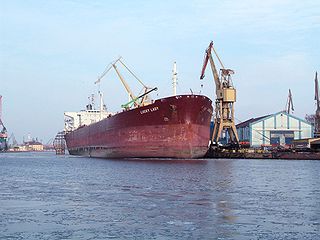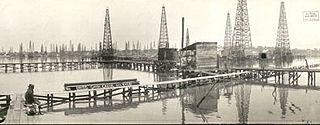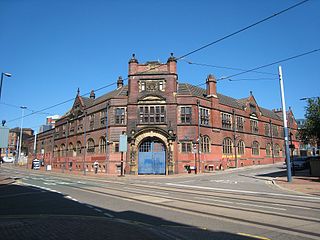Negligence is a failure to exercise appropriate and/or ethical ruled care expected to be exercised amongst specified circumstances. The area of tort law known as negligence involves harm caused by failing to act as a form of carelessness possibly with extenuating circumstances. The core concept of negligence is that people should exercise reasonable care in their actions, by taking account of the potential harm that they might foreseeably cause to other people or property.

An atoll is a ring-shaped island, including a coral rim that encircles a lagoon. There may be coral islands or cays on the rim. Atolls are located in warm tropical or subtropical parts of the oceans and seas where corals can develop. Most of the approximately 440 atolls in the world are in the Pacific Ocean.

The Manchester Bolton & Bury Canal is a disused canal in Greater Manchester, England, built to link Bolton and Bury with Manchester. The canal, when fully opened, was 15 miles 1 furlong (24 km) long. It was accessed via a junction with the River Irwell in Salford. Seventeen locks were required to climb to the summit as it passed through Pendleton, heading northwest to Prestolee before it split northwest to Bolton and northeast to Bury. Between Bolton and Bury the canal was level and required no locks. Six aqueducts were built to allow the canal to cross the rivers Irwell and Tonge and several minor roads.
Dame Shirley, Lady Porter DBE, is a British politician who led Westminster City Council in London from 1983 to 1991, representing the Conservative Party. She is the daughter and heiress of Sir Jack Cohen, the founder of Tesco supermarkets. She was appointed Dame Commander of the Order of the British Empire in 1991 by John Major after delivering victory in Westminster for the Conservatives in the 1990 local elections. While leader of Westminster City Council, Porter oversaw the "Building Stable Communities" policy — later described as the "homes for votes scandal" — and was consequently accused of gerrymandering. The policy was judged illegal by the district auditor, and a surcharge of £27m levied on her in 1996. This was later raised to £42 million with interest and costs. She eventually settled in 2004, paying a final settlement of £12.3 million.
The system of tort law in Australia is broadly similar to that in other common law countries. However, some divergences in approach have occurred as its independent legal system has developed.
Westleigh is a suburb in the Upper North Shore region of Sydney in the state of New South Wales, Australia, 22 kilometres north-west of the Sydney central business district in the local government area of Hornsby Shire.

Overseas Tankship (UK) Ltd v The Miller Steamship Co or Wagon Mound , is a landmark tort case, concerning the test for breach of duty of care in negligence. The Judicial Committee of the Privy Council held that loss will be recoverable where the extent of possible harm is so great that a reasonable man would guard against it.

Rylands v Fletcher (1868) LR 3 HL 330 is a leading decision by the House of Lords which established a new area of English tort law. It established the rule that one's non-natural use of their land, which leads to another's land being damaged as a result of dangerous things emanating from the land, is strictly liable.

The Sydney Town Hall is a late 19th-century heritage-listed town hall building in the city of Sydney, the capital city of New South Wales, Australia, housing the chambers of the Lord Mayor of Sydney, council offices, and venues for meetings and functions. It is located at 483 George Street, in the Sydney central business district opposite the Queen Victoria Building and alongside St Andrew's Cathedral. Sited above the Town Hall station and between the city shopping and entertainment precincts, the steps of the Town Hall are a popular meeting place.
Lateral and subjacent support, in the law of property, describes the right a landowner has to have that land physically supported in its natural state by both adjoining land and underground structures. If a neighbor's excavation or excessive extraction of underground liquid deposits causes subsidence, such as by causing the landowner's land to cave in, the neighbor will be subject to strict liability in a tort action. The neighbor will also be strictly liable for damage to buildings on the landowner's property if the landowner can show that the weight of the buildings did not contribute to the collapse of the land. If the landowner is unable to make such a showing, the neighbor must be shown to have been negligent in order for the landowner to recover damages.
Keystone Bituminous Coal Ass'n v. DeBenedictis, 480 U.S. 470 (1987), is a United States Supreme Court case interpreting the Fifth Amendment's Takings Clause. In this case, the court upheld a Pennsylvania statute which limited coal mining causing damage to buildings, dwellings, and cemeteries through subsidence.

The following is a list of Public housing estates in Ma On Shan, Hong Kong, including Home Ownership Scheme (HOS), Private Sector Participation Scheme (PSPS), Sandwich Class Housing Scheme (SCHS), Flat-for-Sale Scheme (FFSS), and Tenants Purchase Scheme (TPS) estates.

The Goose Creek Oil Field is a large oil field in Baytown, Texas, on Galveston Bay. Discovered in 1903, and reaching maximum production in 1918 after a series of spectacular gushers, it was one of the fields that contributed to the Texas Oil Boom of the early 20th century. The field was also the location of the first offshore wells in Texas, and the second group of offshore wells in the United States. Consequences of the development of the Goose Creek field included an economic boom and associated influx of workers, the founding and fast growth of Baytown, and the building of the adjacent Baytown Refinery, which is now the 2nd largest oil refinery in the United States with a capacity of 584,000 barrels per day. The field remains active, having produced over 150 million barrels (24,000,000 m3) of oil in its 100-year history.

Somme Barracks, Sheffield is a military establishment on Glossop Road in Sheffield, England. The building is owned by the Ministry of Defence and serves as the base of the University of Sheffield Officers' Training Corps, which has been a part of the Yorkshire Officer Training Regiment since 2011. It is a Grade II listed building.

Stieller v Porirua City Council [1986] 1 NZLR 84 is a cited case in New Zealand regarding council liability in tort for negligent inspection.

Cliffside Apartments is a heritage-listed apartment block at 76 Lower River Terrace, Kangaroo Point, City of Brisbane, Queensland, Australia. It was built from 1936 to 1937. It is also known as Cliffiside Flats. It was added to the Queensland Heritage Register on 27 February 2004.

Morton v Douglas Homes Ltd has become an important case in New Zealand, as a result of the leaky homes crisis. The salience of the case comes from the fact that Justice Hardie Boys held the directors of a building company personally liable for damage caused by defective foundations. The case has been described in the Court of Appeal as one that, "certainly provides some authority for the view that the directors of a building company with actual control of particular building operations owe a duty of care, associated with that control."
Lamb v Camden LBC[1981] EWCA Civ 7, [1981] QB 625 is a leading case in English tort law. It is a Court of Appeal decision on negligence and the test of reasonable foreseeability of damage, especially where the damage has been caused by third parties not the defendant him or herself.
Cleveland Terminal and Valley Railway Co. v. Cleveland Steamship Co., 208 U.S. 316 (1908), is a decision by the United States Supreme Court which held that damages caused to a bridge pier, bridge protective pilings, and docks by a vessel on navigable waters was not a cause for action under United States maritime law. The ruling was legislatively overturned in 1948.

69 Windmill Street, Millers Point is a heritage-listed residence and former retail building located at 69 Windmill Street, in the inner city Sydney suburb of Millers Point in the City of Sydney local government area of New South Wales, Australia. It was built from 1845 to 1901. It is also known as Hit or Miss Hotel; Empire Service Hostel. It was added to the New South Wales State Heritage Register on 2 April 1999.











